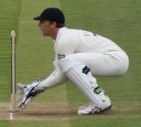What progress have Bangladesh made?
Paul Wood |
“We played loose shots and the tendency to go for strokes caused our downfall. Also we did not apply ourselves as we did in the first innings. We have to learn the importance of temperament and concentration. We have to work on our faults.”
These were the words of Bangladesh’s captain, Naimur Rahman, in their first ever Test match back in November 2000. For the record the opponents were India and the outcome was a predictable nine-wicket defeat, despite a promising first innings where they registered a rare total of 400 (they have made 400 and over on only five other occasions in their Test match career to date).
The harsh facts are that 63 Tests later and it could be Shakib Al Hasan saying those exact things in a press conference following another one-off Test defeat, this time to to New Zealand. Unfortunately for Bangladesh, these weaknesses pointed out all those years ago by Rahman have had a consistent presence in their Test match play since their introduction to the five-day format.
During their time as a Test match playing nation, Bangladesh have registered just three Test victories in a little over nine years. The first win did not arrive till January 2005, with Zimbabwe the unlucky opponents. It was during this game at Chittagong that they reached their highest innings total ever, making 488 in the first innings. With the bat it was the then skipper, Habibul Bashar that led the way with 94 and 55, with spinners Mohammad Rafique and Enamul Haque Jnr doing the damage with the ball.
Their two other victories came in last year’s trip to the Caribbean, against a much under-strength West Indies, who were embroiled in contractual disputes, and not for the first time.
The development of Bangladesh always had to be, and continues to be one of patience. They would not become an ultra-competitive team overnight, certainly not in terms of quality comparison. It has been half a step forward, several back.
With a domestic structure that has not improved as quickly as necessary to produce players with the attributes to step up to the lofty challenges of Test cricket, the slow progress Bangladesh have made so far was inevitable.
Each year they make amendments to their domestic schedule, and for this season rather than the six sides playing each other home and away, equating to a ten match season, they have incorporated a second round, which means two sides will be eliminated after just five first-class games. This caused consternation among numerous leading players that were unimpressed by the new format, and the match fees being paid.
Any aspiring cricketer playing in the hope of reaching Test level must play more than five first-class games a season. By making this change the Bangladesh Cricket Board aim to bring more intensity into the four-day games, make as many games as possible important ones, learning how to play under pressure. There must be a better way that does not compromise young players progression in such a way by allowing them such limited first-class cricket.
However, due to them being given Test status, it appears fair to say that the structure of domestic cricket in Bangladesh has improved. The money gained from their status has allowed the nation to develop. There is no question that in terms of quality in the squad back then, they were far from ready for the challenges of Test cricket at that time.
Bangladesh were given full Test playing status in 2000, but have played in One-Day internationals since 1986, they endured a similar wait for their first win in this format (against a full-member side), finally coming in 1999 in their 35th match against Pakistan.
They are now far more competitive in the ODI arena. They have registered impressive victories, who can forget Mohammad Ashraful’s 100 against Australia at Cardiff in 2005 that gave them a five wicket victory. The wins in the Caribbean World Cup in 2007 against India and South Africa were also huge indications that Bangladesh deserved to be taken more seriously in this format. Despite these determined glimpses of hope, the consistency is still lacking.
The talent within Bangladesh has been on show with their under-19 age group for some time in the 50-over format, but how this potential is harnessed is the key to future successes. The battle for many countries without great financial rewards are that these talented youngsters are lured into the cash cow of Twenty20 cricket.
Already the full side have suffered availability problems when several players defected to the Indian Cricket League.
The present Test side does offer hope that they can reach a competitive level. They are managing to work themselves into very positive match situations, but without the confidence, winning know-how, they are unable to grasp the moment.
A prime example occurred in January during the opening Test against India at Chittagong. Bangladesh’s attack restricted the visitors to 243 in the first innings, it could have been much worse for India had Sachin Tendulkar not rescued them with yet another unbeaten century. The stage was set for Bangladesh to assert some real pressure, especially when Tamim Iqbal and Imrul Kayes put on 50 for the opening wicket. However, they could not surpass India’s total, and from that point on the game slipped through their fingers. A brief position of strength was allowed to drift from them, the ability to play consistently good cricket over a long period of time still evades them.
Twenty20 should for now take a backward step to enable them to master the skills essential for Test cricket.
When Ashraful became the youngest ever Test centurion in 2001 with a hundred against Sri Lanka in Colombo, big things were expected, perhaps unfairly so. He has never lived up to that potential, the weight of expectation bestowed upon him from a partisan and enthusiastic Bangladeshi following has so far proved too much. His form warrants a spell out of the Test side, but with so few options, Bangladesh have opted to keep his experience in the side, when time out is clearly what is needed.
On the positive side, they now have an attack that has the potential to threaten most teams. Rubel Hossain, who has a look of Lasith Malinga with his slingy action, is capable of delivering the ball at high speeds, in excess of 140 kph, even if the accuracy is not quite there yet. Along with Shahadat Hossain, who has taken on the mantle of the leader of the pace attack in Mashrafe Mortaza’a injured absence, they have Shafiul Islam whose powerful action after a leisurely jog to the crease, is sure to catch out one or two batsmen for pace.
Captain Shakib Al Hasan provides an excellent spin option. He gives the ball a big rip and gains many wickets with his well disguised arm ball. Throw in the exceptionally talented and aggressive opening batsman Tamim Iqbal, the growing reputation of Mahmudullah the batsman, the ability of a run scoring wicket-keeper in Mushfiqur Rahim, and things can be construed as being quite rosy in the Bangladeshi garden.
Their Australian coach Jamie Siddons takes his indications of their growing stature, not necessarily by winning matches, but by seeing gradual improvements on a daily basis by the raising of standards by individuals.
But would Bangladesh benefit from playing against lesser accomplished teams ? Australia, India, England and South Africa could all field strong enough ‘A’ sides to give Bangladesh a serious assessment of their abilities, while Bangladesh would also fancy their chances in learning how to win Test matches and the inevitable momentum that brings. Even the crowds may swell to see some competitive action.
Bangladesh is packed with cricket lovers, the passion is clear, yet opinions on the best way forward continues to be a hotly debated topic.




I can think of one.
Their population has grown by 20 million.
Comment by SJS | 12:00am GMT 1 March 2010
There has been some progress, but it’s been painfully slow. They’re losing Tests by 5 wickets or 75 runs rather than by an innings and 150. Their average totals are now in the 250 region rather than the sub-170 of not many years ago. But they badly need a match-winning fast bowler or two.
Comment by stumpski | 12:00am GMT 7 March 2010